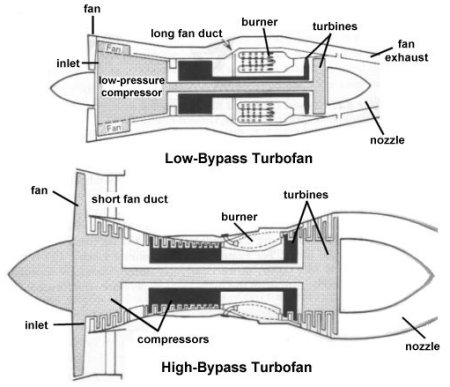turbofan engine

Comparison of low-bypass and high-bypass turbofan engines.
A turbofan engine is a type of jet engine which is similar to a turbojet but in which there is a fan section in front of the compressors. The fan, another rotating series of blades, is also driven by the turbine, but its main purpose is to force a large volume of air through outer ducts that go around the engine core. Although this "bypassed" air flow travels much more slowly, the large mass of air that is accelerated by the fan creates a significant additional thrust to that produced by the turbojet core without burning any extra fuel. Thus, the turbofan is much more fuel efficient than the turbojet. In addition, the low-speed air helps to cushion the noise of the jet core making the engine much quieter.
Turbofans fall into two main categories – low-bypass ratio and high-bypass ratio. The bypass ratio refers to the volume of incoming air that passes through the fan ducts compared wth the volume of incoming air that passes through the jet core. In a low-bypass turbofan, only a small amount of air passes through the fan ducts and the fan has only a small diameter. The fan in a high-bypass turbofan is much larger to force a large volume of air through the ducts. The low-bypass turbofan is more compact, but the high-bypass turbofan can produce much greater thrust, is more fuel efficient, and is much quieter.
See also turbofan engine and ramjet.


